Christianity brought new hope, new dreams and new prosperity
Saturday 12 August 2023 | Written by Rod Dixon | Published in Features, In Depth, Weekend
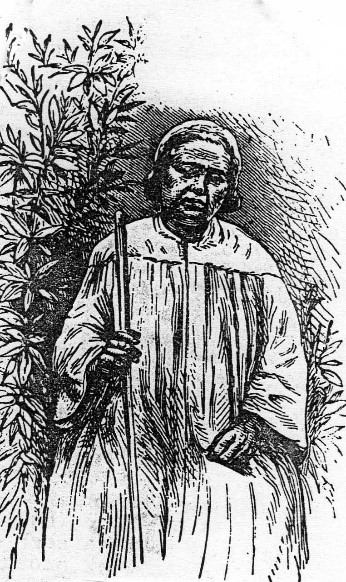
Tepaeru-Ariki as depicted in later years. Tepaeru-Ariki was the daughter of Rupe. She was also the grand-daughter of Makea Tinirau Ariki of Arai-te-Tonga, Rarotonga. She was taken to Aitutaki by the captain of the “Cumberland” in late 1814 and subsequently taken in by Tamatoa Uma-tetiki Ariki of Arutanga. Tepaeru-Ariki was one of the first to embrace Christianity following the arrival of Papehia and Vahapata on 26 October 1821.
When Aaron Buzacott opened the Takamoa Theological College on Rarotonga in 1843, one of the first students that he took in for Theological Training was a son of Tepaeru-Ariki. His name was Rupe. 23081102
Historian and author Howard Henry has been fascinated by the birth of Christianity in the Cook Islands for many years. In a weekly series, Henry chronicles the arrival of Christianity to the Cook Islands and its role in building the nation. In his final article, he talks about the impact of Christianity in the Cook Islands.
The first island to receive the Gospel and the Christian faith was Aitutaki. This happened on 26 October 1821.
In the few short years that followed, various other islands in the present-day Southern Group of the Cook Islands, were also “colonised by the Christian faith” as well.
The arrival, and establishment of Christianity on each island was actually a “unique story” in itself. Each island had a different set of circumstances with regard to the initial arrival of the Gospel, and what subsequently happened during the very early years of Christian consolidation.
But a common denominator with all of this, was that each Christian village, that was established on each different island, had a “Native Teacher” who was the “Principal Architect” of this Christian village creation. So the “Native Teacher” was in charge, and had total control, of everything that happened within his village of Christian jurisdiction.
All these “Native Teachers” had been trained at the London Missionary Society Theological College on Raiatea. So they had all received the same kind of “Religious Education” at that facility.
It was the European Protestant Missionaries from lower-middle-class England, who had instructed these “Native Teachers” on how they were to act and behave when placed at an island location. Their main objective being to consolidate the Christian faith amongst all those people who lived at that particular place.
So when “Native Teachers” took up their various posts, they all acted in a very similar way in terms of not only introducing a new Christian religion, but the “Native Teachers” were also introducing a whole new way-of-life that was vastly different to what people had been living during the pre-Christian era.
As each Christian village was established, the “Native Teacher” then started introducing a number of “Church Laws” by way of proclamation. There was no discussion or debate concerning these new “Church Laws”. They simply came into existence on the say-so of the resident “Native Teacher”.
This person was now the “Paramount Chief” of the Christian village. So all Christians living in that village had no choice but to abide by all the “Church Laws” that the “Native Teacher” had introduced by way of public declaration. They simply had no choice but to live their day-to-day lives according to the “Church Laws” as established by their resident “Native Teacher”.
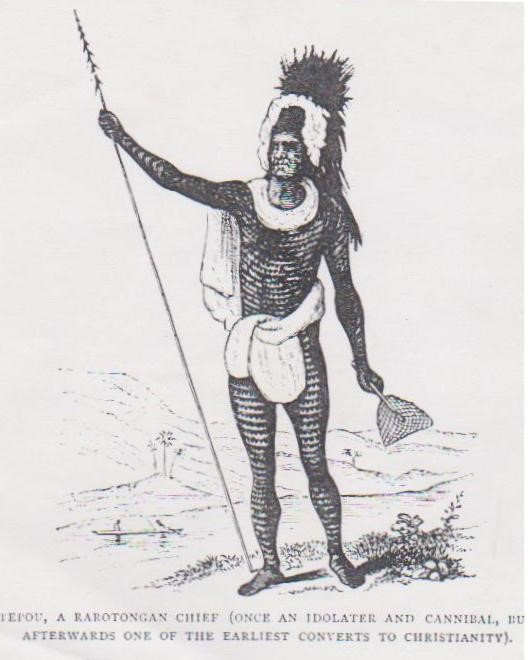
Te-Pou: A Mataiapo at Avarua. At the time Papehia and the Gospel landed at Rarotonga on 25 July 1823, Pe-Pou was a Mataiapo in the District of Avarua and its surrounding area. He was one of the early converts to the Christian faith. Two or maybe three generations after Te-Pou, the five Ariki on Rarotonga concluded that the person carrying the “Vakatini Title” should be elevated to be of equal status to the other five Ariki. And so Vakatini Ariki came to be recognised as being of equal standing on Rarotonga to Pa, Kainuku, Makea Nui, Karika and Tinomana Ariki. This island now had six Ariki in residence. Source of Illustration: “From Darkness to Light in Polynesia”, by Rev. William Wyatt Gill, LL.D.
First Published by William Clowes and Sons, London, England, 1894. 23081105
Much could be written about the “negative” side of the Christian faith and some of the unfortunate things that happened to people and their various communities as a result of accepting this new religion.
It is true that some of the “Church Laws” the “Native Teachers” introduced were rather harsh and dictatorial. But many of these “Church Laws” were based on the prevailing laws that existed in England during this time. And many of those English Laws were just as harsh as those “Church Laws” which the “Native Teachers” then imposed on their respective Christian communities.
By accepting the Gospel and the Christian faith, the positive things that happened to people and their various communities over the years that followed, were far more beneficial with regard to the quality of life and standard of living that ordinary people were able to enjoy on a day-to-day basis.
Right from the very beginning of his “Religious Teachings”, a “Native Teacher” would talk to any of those in the community who would listen, that God (Jehovah) was of the Spirit kind. God was not a manifestation of a human being.
It was God who made “everything” that existed on earth. And God was a spirit who would never fade. That “Spirit of God” would never die.
Papehia, for example, would say that “The Spirit of God is forever present . . . everywhere – all the time”.
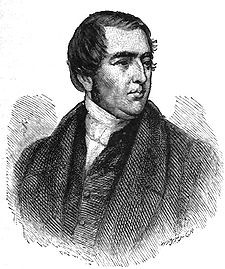
Reverend John Williams. The man who “spear-headed” the Christian “Revolution” across most of the South Pacific from the Marquesas Islands in the east to Papua New Guinea in the west. SOURCE: Auckland Public Library/23081103
Papehia would talk about the life and times of Jesus Christ and the angels in heaven. He would talk about the everlasting and the “power” of prayer. He would talk about the Ten Commandments, the Apostles and some of the various stories that are included in various parts of both the Old and New Testaments.
Papehia would talk about God as a “Loving God” and how all those who believed in him were “loving people” whose spirit would eventually go to heaven and rest in the place of the “Everlasting”.
Papehia would say that for all those people who chose to embrace Christianity, there would be no more tribal warfare, there would be no more fighting and no more killing.
Everyone will live in peace with each other and help each other where they can during their day-to-day lives.
As Papehia continued to move throughout the community of Aitutaki, and then later on Rarotonga, he often spoke of God being the “Heavenly Father”. Papehia would give an account on how God had created the world and how everything in existence came to be as a result of “God’s Work”.
Papehia would talk about Adam and Eve and the Garden of Eden. He would talk about the birth of Jesus Christ as the son of God, and how he was sacrificed on the cross for the sins of mankind. Papehia would talk about his resurrection and the legacy Jesus Christ left to all those who were “True Believers”.
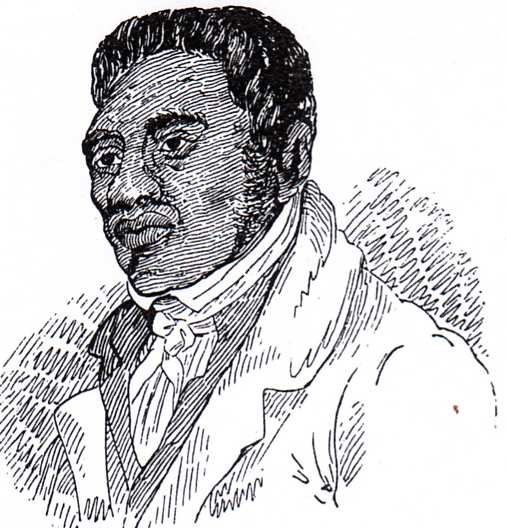
A youthful Papehia portrayed around the time he and Vahapata landed on Aitutaki. Papehia played a very significant role with the introduction of Christianity to Aitutaki. But his greatest influence was the part he played to get Christianity firmly established on Rarotonga. Papehia married Te-Vaerua-o-te-Rangi who was the eldest daughter of Tinomana Enua-ruru-Tini Ariki. They apparently had eight children of which most subsequently left descendants. So the legacy of Papehia is still very much alive today with many of his descendants scattered all around the world. 23081104
The way that Papehia operated during these early Christian years, was basically the same as other “Native Teachers” who had been placed at different island locations. They had all been trained in the same style. And so they all acted and operated very much the same way.
As each “Native Teacher” took up his post on each particular island, this person had a basic understanding of the “Social Structure” that existed within each particular tribe. This was because the “Social Structure” was very similar to what it was during the pre-Christian time on Tahiti, Raiatea, or any other island a “Native Teacher” may have come from in that vicinity.
In this case, the Ariki was paramount and his voice was the “Law of the Tribe”. Below him were various Mataiapo and Rangatira who each had particular responsibilities within their respective tribes. And below these tribal leaders were the various people who made up the population of the tribe.
So the “Social Structure” that existed in Pre-Christian times was very regimented. It was surprisingly well organised. Every man knew “his place” within his tribe and had a basic understanding of what his obligations and responsibilities were.
So the “Native Teachers”, who had been trained at Raiatea, understood most of this because it was a very similar situation to the pre-Christian circumstances that existed on the various islands from which they had originally come from.
When a “Native Teacher” first landed on any particular island to introduce the Christian faith, that person did not attempt to change the basic “Social Structure” that was in existence at that time. But rather, a “Native Teacher” would use that same “Social Structure” to his advantage as a means to establish and then consolidate the Christian faith.
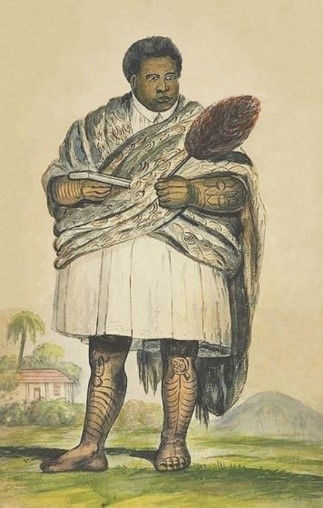
Makea Pori Ariki. Makea Pori succeeded his father Makea Tinirau Ariki in 1826.
He died at Rarotonga on 28 October 1839 and was succeeded by Makea Davida Ariki. ORIGINAL SOURCE: Not known. 23081106
The most significant person in these island communities was the resident Ariki. And so it was to that person that a “Native Teacher” would direct his attention and influence in the first instance. Once an Ariki had endorsed the arrival of the Gospel and the Christian faith to their respective communities, then that same Ariki had the power, and “authority”, to influence many of those people who were living within his tribe.
Christianity not only brought a new religion to various island communities, but it also brought a whole new style of “Human Civilisation” to that in which people had lived during the pre-Christian era.
Christianity brought peace to various island communities. It brought a basic set of laws in terms of law and order and how people were to behave during their day-to-day lives.
Christianity brought prosperity with the later introduction with a whole raft of material goods that never existed within the island communities during the pre-Christian times. Christianity also brought into existence a written language which was basically the dialect of Rarotonga.
So Christianity brought a “Cradle to the Grave” transformation to so many people living on various remote South Sea islands.
Christianity brought so many people out of the “darkness of the past” and into the “light of the future”.
Christianity gave people “new hope”, “new dreams” and a new prosperity, to which they could aspire to as they lived a far better quality of life and standard of living to what they had before the arrival of the Gospel and the Christian faith to their respective communities.
Christianity gave people self-respect.
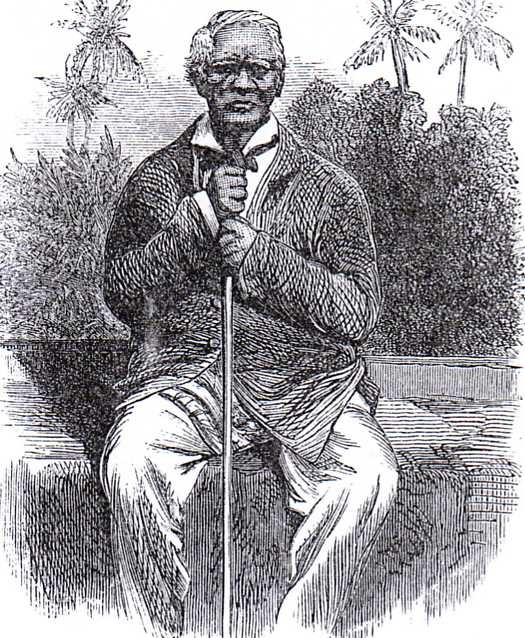
King Numangatini . . . the Paramount Ariki of Mangaia in later years of life. SOURCE: “Life in the Southern Isles”, by Rev. William Wyatt Gill, LL.D Published by the Religious Tract Society, London, England, 1876. 23081109
Christianity created village communities where people, of all ages, were able to live, work and support each other every single day of their lives.
Christianity created a “new spirit” within each Christian community where God was looked upon as the “Heavenly Father”. And all those who believed in the Lord were indeed “The Children of God”.
So Christianity created the “basic framework” in which each island, and each tribe of people, were later able to mould and develop themselves to what they are today.
Christianity therefore put in place the “Foundation Stones” as to how each island, and each tribe of people, were able to evolve and develop their various island communities over many years which later followed.
So Christianity was very much part in creating the Cook Islands to be the country that it is today.
Hence, a considered opinion – “Christianity created a Nation”.
This nation being … the Cook Islands.
Kia Orana e Kia Manuea.
SIDEBAR
Gospel
Days
for each
island in
the Cook
Islands
Aitutaki: 26 October 1821.
Atiu: 19 July 1823.
Mitiaro: 21 July 1823.
Mauke: 23 July 1823.
Rarotonga: 25 July 1823.
Mangaia: 15 June 1824.
Manihiki: 8 August 1849.
Rakahanga: 15 August 1849.
Penrhyn: 13 March 1857.
Pukapuka: 6 December 1857.
Palmerston: 25 May 1863.












































